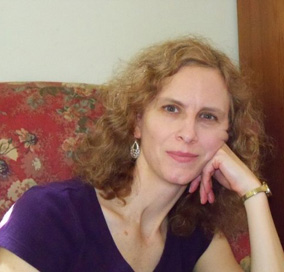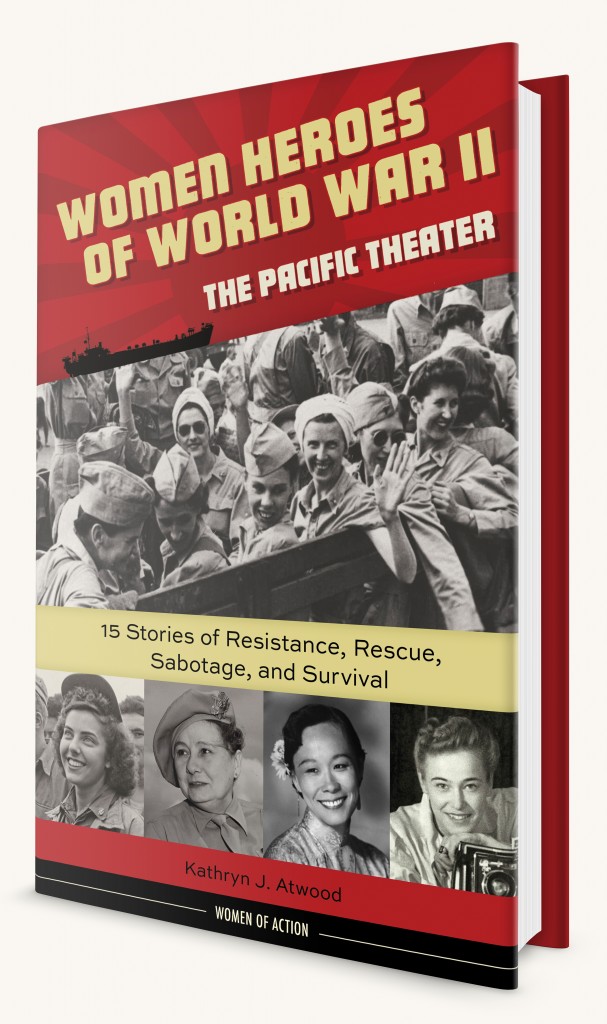 Kathryn J. Atwood has written several books for our Women of Action series: Women Heroes of World War II, Code Name Pauline, and Women Heroes of World War I. Although these titles are categorized as YA, they also attract a range of adult readers. Booklist says her newest book, Women Heroes of World War II—The Pacific Theater: 15 Stories of Resistance, Rescue, Sabotage, and Survival (October 1), is “part helpful informational text, part enthralling narrative; each of these 15 profiles could constitute a cliffhanger screenplay […] Here the drama, much of it horrifying, plays out so effectively on the page—it leaps out like vivid 3D—that readers of any age will come away both shaken and inspired.”
Kathryn J. Atwood has written several books for our Women of Action series: Women Heroes of World War II, Code Name Pauline, and Women Heroes of World War I. Although these titles are categorized as YA, they also attract a range of adult readers. Booklist says her newest book, Women Heroes of World War II—The Pacific Theater: 15 Stories of Resistance, Rescue, Sabotage, and Survival (October 1), is “part helpful informational text, part enthralling narrative; each of these 15 profiles could constitute a cliffhanger screenplay […] Here the drama, much of it horrifying, plays out so effectively on the page—it leaps out like vivid 3D—that readers of any age will come away both shaken and inspired.”
Here Atwood discusses her fascination with World War II, how she handles writing for a younger audience, and one of her favorite chapters in the new book.
In the early stages of writing my proposal for WHofWWII, it became obvious that I wouldn’t be able to include the stories of Pacific War women if I was to include enough Europeans to represent the wide variety of roles those women played. Because of this and because there were so many more English-language memoirs and biographies available regarding European rather than Asian resisters, I decided to focus on Europe.
However, when a quirky TV show, America: Fact vs. Fiction, contacted me, asking how much I knew about the American women who cracked Japanese codes during the war, it made me realize that a book covering the Pacific Theater could include a large number of American women, especially with the 75th anniversary of the Pearl Harbor attack right around the corner. Although I didn’t ultimately include stories of the code-cracking women, there are nine Americans featured in the book.
I grew up with three basic images from the Pacific War: the Pearl Harbor attack, the mushroom clouds, and the Japanese American internment camps. As my interest in WWII deepened, I also gained a general knowledge of the Bataan Death March and the Rape of Nanking. But because my dad and his three brothers were all veterans of the air war in Europe, my interest in the war, like that of many American WWII buffs, always gravitated more towards the European Theater. So until I initiated my research for this book, I had no idea how much Japanese and German fascists had in common, especially their genocidal racial hatred: the Nazis for the Jews and Slavs, the Imperial Japanese for the Chinese. The one huge difference I discovered was that while the takeaway images from the European war—the concentration camps—left a powerful visual reminder of where racial hatred can lead, the takeaway images of the Pacific War, at least for many Americans, became the two mushroom clouds. Behind those tragic clouds, however, were unspeakably horrific war crimes eventually swept under the rug by a United States eager to make a Cold War ally out of their former enemy.
This was definitely a challenge. Years ago, when my husband was reading about the Pacific War in order to understand his WWII vet father, he couldn’t stomach the accounts and had to keep stopping. If a grown man couldn’t handle the details of this war, how could I present the same material for impressionable teens? How could I tone down the graphic elements without watering down the truth?
I received help in the form of a brilliant group of acquaintances who are all involved with history, reading, and young people—actually two members of this A-team are young people—and they cheerfully agreed to answer questions and review the most difficult portions of the book before I turned it in. And during the editing process, my very helpful CRP editor, Lindsey Schauer, also had some great suggestions that helped me strike the right balance.
Before writing my first book, I considered the WWII–era Dutch and French to be the ultimate heroes. Working on my first book tarnished that image somewhat because while these nations did produce impressive resistance movements, both also had a strong, active core of collaborators. But after working on Pacific Theater, I realized that neither movement can compare to the Philippine Resistance in terms of the percentage of involved civilians as well as its winning collective personality.
My favorite story is that of Yay Panlilio, a Filipino American journalist who fell in with a guerrilla band and became its second-in-command. She held her own against the leader, Marking, her partner in love and war, proved by the following passage which always makes me smile. [The complete chapter is excerpted below.]
Marking knew Yay was right, and he often followed her advice. But sometimes getting him to listen took enormous effort. One day a guide named Pascual was brought into the camp by a guerrilla who accused him of working with the Japanese. Marking immediately ordered his execution.
Yay knew the accused man. He had once risked his life to hide some Americans. His wife had sheltered Yay. The present evidence against him was circumstantial and weak.
 “We’ll kill him for betrayal,” said Marking.
“We’ll kill him for betrayal,” said Marking.
“You’ll prove betrayal first,” replied Yay.
“Prepare a firing squad,” said Marking.
“You can’t kill him, Marking,” said Yay.
“I will kill him,” he insisted, pulling out his .45 pistol.
Yay stood next to the condemned man. “Then shoot us both,” she said.
The other guerrillas moved slowly out of the line of fire. It was silent. Yay and Marking stared steadily at each other. Neither one would back down. Marking wanted to prove he was in charge. Yay wanted him to be reasonable and just.
Finally, Marking gave in. “You know I can’t shoot you. I love you.”
[Scroll down to read the complete chapter.]
Yes, because stories of women in war situations are generally less known. I feel that my books, and others like it, do a service to the people whose courageous choices cry out for some sort of remembrance, and also inspire young people in search of role models.
Women Heroes of World War II—The Pacific Theater: 15 Stories of Resistance, Rescue, Sabotage, and Survival officially publishes October 1, 2016. It is available wherever books and e-books are sold. Keep up with author Kathryn Atwood on Twitter, Facebook, and Goodreads. Learn more at www.kathrynatwood.com
[Get it now $20] [Request a review copy]
Read an excerpt:
1 Comment
[…] In an interview, Atwood realizes that when people think of WWII in Europe, they instantly think of the concentration camps. However, when it comes to the Pacific, most people’s image is immediately the mushroom clouds from the atomic bombs. […]